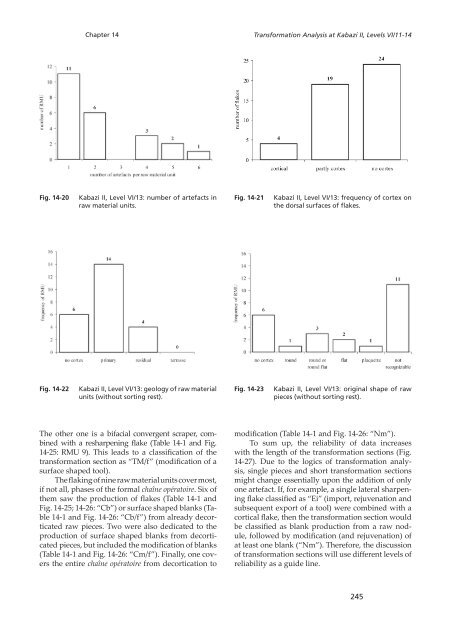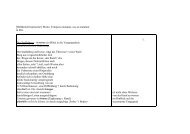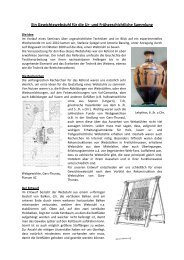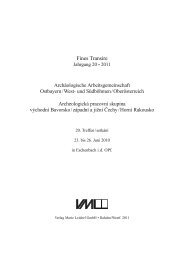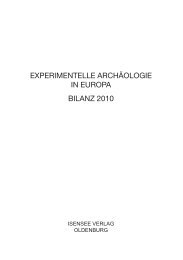Thorsten Uthmeier & Jürgen Richter
Thorsten Uthmeier & Jürgen Richter
Thorsten Uthmeier & Jürgen Richter
Create successful ePaper yourself
Turn your PDF publications into a flip-book with our unique Google optimized e-Paper software.
Chapter 14<br />
Fig. 14-20 Kabazi II, Level VI/13: number of artefacts in<br />
raw material units.<br />
Fig. 14-22 Kabazi II, Level VI/13: geology of raw material<br />
units (without sorting rest).<br />
The other one is a bifacial convergent scraper, combined<br />
with a resharpening flake (Table 14-1 and Fig.<br />
14-25: RMU 9). This leads to a classification of the<br />
transformation section as “TM/f” (modification of a<br />
surface shaped tool).<br />
The flaking of nine raw material units cover most,<br />
if not all, phases of the formal chaîne opératoire. Six of<br />
them saw the production of flakes (Table 14-1 and<br />
Fig. 14-25; 14-26: “Cb”) or surface shaped blanks (Table<br />
14-1 and Fig. 14-26: “Cb/f”) from already decor-<br />
ticated raw pieces. Two were also dedicated to the<br />
production of surface shaped blanks from decorticated<br />
pieces, but included the modification of blanks<br />
(Table 14-1 and Fig. 14-26: “Cm/f”). Finally, one covers<br />
the entire chaîne opératoire from decortication to<br />
Transformation Analysis at Kabazi II, Levels VI/11-14<br />
Fig. 14-21 Kabazi II, Level VI/13: frequency of cortex on<br />
the dorsal surfaces of flakes.<br />
Fig. 14-23 Kabazi II, Level VI/13: original shape of raw<br />
pieces (without sorting rest).<br />
modification (Table 14-1 and Fig. 14-26: “Nm”).<br />
To sum up, the reliability of data increases<br />
with the length of the transformation sections (Fig.<br />
14-27). Due to the logics of transformation analysis,<br />
single pieces and short transformation sections<br />
might change essentially upon the addition of only<br />
one artefact. If, for example, a single lateral sharpening<br />
flake classified as “Ei” (import, rejuvenation and<br />
subsequent export of a tool) were combined with a<br />
cortical flake, then the transformation section would<br />
be classified as blank production from a raw nodule,<br />
followed by modification (and rejuvenation) of<br />
at least one blank (“Nm”). Therefore, the discussion<br />
of transformation sections will use different levels of<br />
reliability as a guide line.<br />
245


